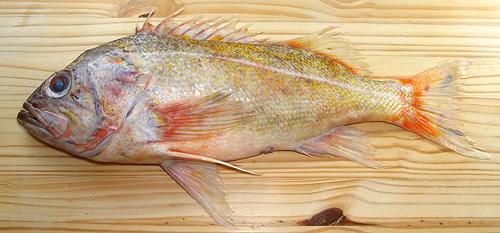 [Orange Rockcod, Rockcod, Sebastes pinniger]
[Orange Rockcod, Rockcod, Sebastes pinniger]
One of the many varieties of deep water rockfish caught all along the Pacific coast, Canary Rockfish is found from Baja California to the Gulf of Alaska. They can grow to 29 inches and 10 pounds, but the photo specimen was 23 inches and 5 pounds 12-1/8 ounces. This fish is sometimes more orange than the one in the photo, and sometimes more yellow. The photo specimen was purchased from a Philippine market in Los Angeles for 2014 US $2.99 / pound.
More on Rockfish.
Canary Rockfish is a prized eating fish (when fresh) with light, moderately flavored flesh. Interestingly, the flesh has more connective tissue than most fish and is a little "tough" if given a short poach. With 15 minutes simmering it flakes apart easily into large flakes. Used in soup, it shouldn't be simmered much longer than that. This is a very easy fish to eliminate all bones. There is a wide dark layer under the skin, with a slightly different texture, but it does not have a strong taste.
This is not a good fish for baking or grilling whole because the head is so large. It is not good for these methods with the head and tail removed (pan dressed) because of the extreme skin shrink. It is best used as skinless fillets, pan fried with a light dusting of rice flour, or poached. Use a light sauce so as not to mask the flavor of the fish.
Buying: This is an occasional fish in the Asian fish markets here in Southern California - you buy it when you see it. The Rockfish Fishery is tightly regulated for sustainability all along the Pacific coast, so it is probably seldom appears in inland markets.
Scales: This fish is completely covered with fairly large, thin but stiff scales that have good adhesion. They will fly around a lot when scraped off, and many capsize and have to be pulled off with long nose pliers. because they pull a little harder than most people's fingernails can stand. There are a few along the centerline that pull particularly hard.
Cleaning: Nothing particularly unusual here, but large size makes for some difficulty. The esophagus is very tough and will need to be cut, and there are a number of tough membranes that will have to be cut with your filleting knife. The gills are huge and pull very hard, but you probably won't be using the head from this fish so don't need to pull them.
Filleting: This is not a hard fish to fillet, having a very coherent fin and bone structure. When you get to the ribcage, the ribs are easy to follow and you could shave the fillet off of them, but I always cut them from the backbone and pull them from the fillet for maximum yield. They pull fairly easily and cleanly. The skirt on these fillets is meaty and has no off flavor if the fish is fresh. There are centerline spines to be pulled for the length of the body cavity. They are easy to find because they are very large, but they pull fairly easily straight forward.
Skin: The skin does not have a strong or "off" flavor, and is somewhat gelatinous when cooked, but shrink is extreme, so it must be removed for any method of cooking. It is tough, and can be easily removed using the standard long knife and cutting board Method. I recommend cutting off the skirt and skinning it separately because it makes the fillet too wide to skin reliably.
Yield: A 5 pound 12-1/8 ounce fish yielded 2 pounds 5-3/4 ounces of skin-on fillet (41%) and 2 pounds 1-3/4 ounces skin-off (37%). Yield is a little low because the head is so large. The skirt is meaty, consisting of 2 ounces of the fish described here, or 1-3/4 ounces skin-off.
Stock: The head, fins and bones make a murky stock with a fair amount of oil and a flavor that is not to my liking. I did not use the skins when testing this.
sf_rockcanz* 060805 r 1141128 - www.clovegarden.com